Satas D., Tracton A.A. (ed.). Coatings Technology Handbook
Подождите немного. Документ загружается.

This Page Intentionally Left Blank
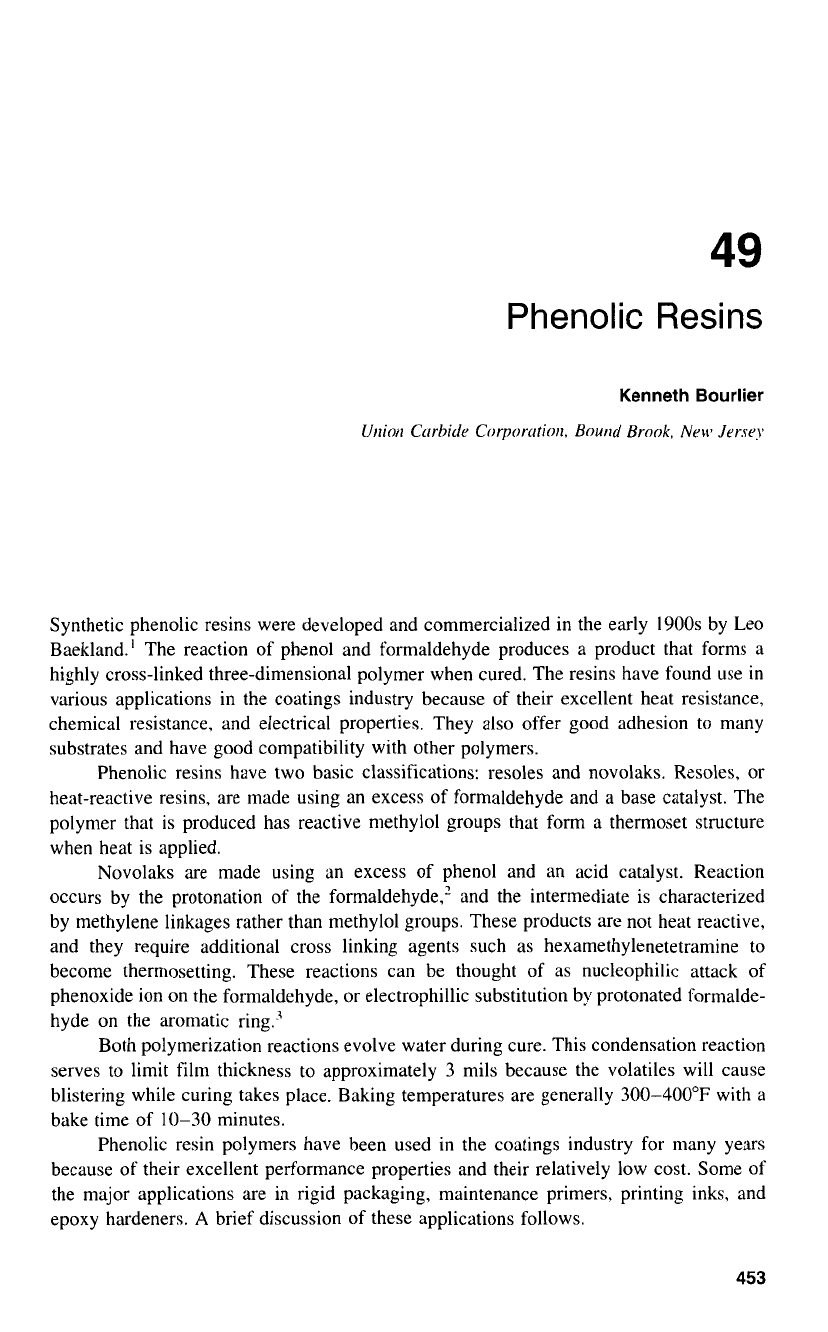
49
Phenolic Resins
Kenneth Bourlier
Urliorl Ctrrhide Corporcrtiorl.
Bourld
Brook,
Nrrtr
Jersey
Synthetic phenolic resins were developed and commercialized in the early
1900s
by Leo
Baekland.' The reaction of phenol and formaldehyde produces a product that forms a
highly cross-linked three-dimensional polymer when cured. The resins have found use
in
various applications in the coatings industry because of their excellent heat resistance,
chemical resistance, and electrical properties. They also offer good adhesion
to
many
substrates and have good compatibility with other polymers.
Phenolic resins have two basic classifications: resoles and novolaks. Resoles, or
heat-reactive resins, are made using an excess
of
formaldehyde and a base catalyst. The
polymer that is produced has reactive methylol groups that
form
a thermoset structure
when heat is applied.
Novolaks are made using an excess
of
phenol and an acid catalyst. Reaction
occurs by the protonation of the formaldehyde,' and the intermediate is characterized
by methylene linkages rather than methylol groups. These products are not heat reactive,
and they require additional cross linking agents such as hexamethylenetetramine to
become thermosetting. These reactions can be thought of as nucleophilic attack of
phenoxide ion
on
the formaldehyde, or electrophillic substitution by protonated formalde-
hyde on the aromatic ring?
Both polymerization reactions evolve water during cure. This condensation reaction
serves to limit film thickness
to
approximately
3
mils because the volatiles will cause
blistering while curing takes place. Baking temperatures are generally
300-400°F
with a
bake time
of
10-30
minutes.
Phenolic resin polymers have been used in the coatings industry for many years
because of their excellent performance properties and their relatively low cost. Some of
the major applications are in rigid packaging, maintenance primers, printing inks, and
epoxy hardeners.
A
brief discussion of these applications follows.
453
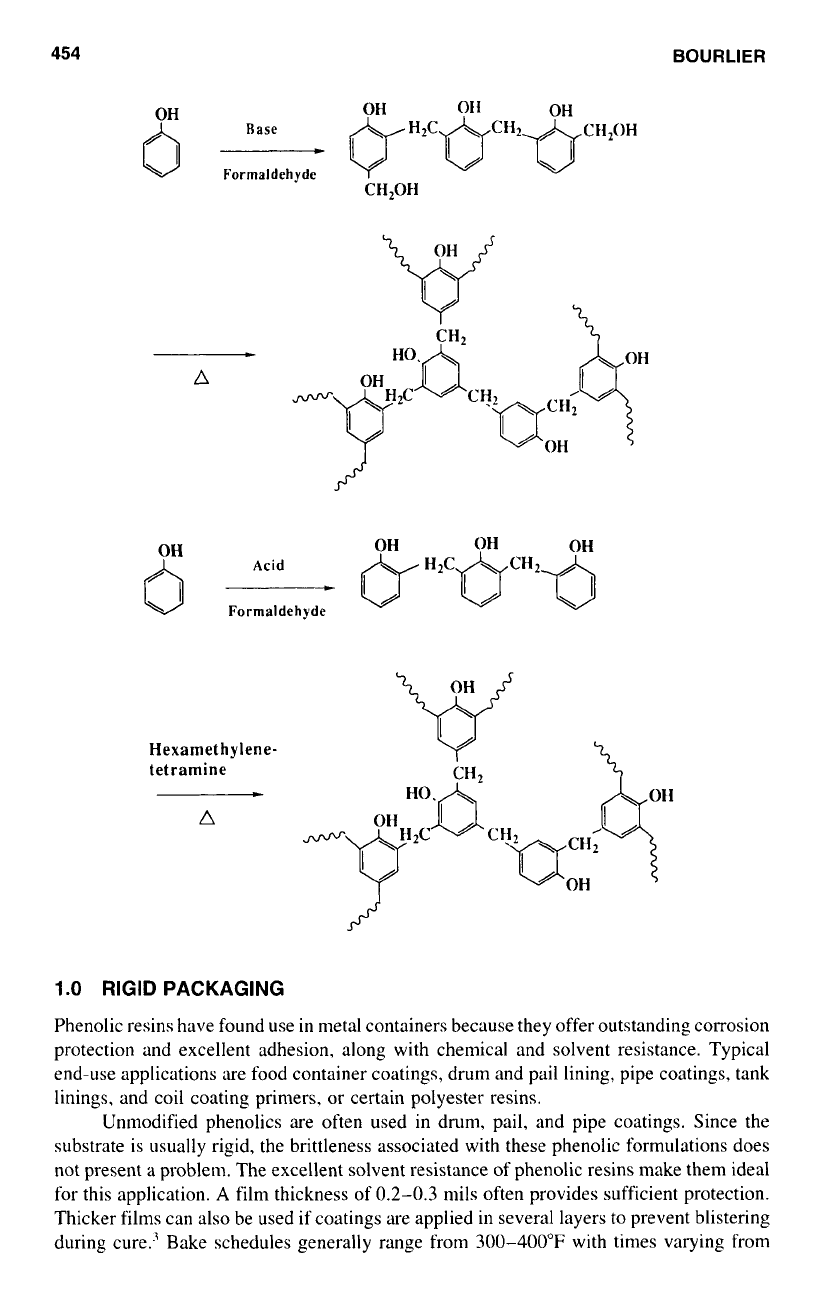
454
BOURLIER
4
A
Acid
-
Formaldehyde
Hexamethylene-
tetramine
D
A
CH2
1.0
RIGID PACKAGING
Phenolic resins have found use
in
metal containers because they offer outstanding corrosion
protection and excellent adhesion, along with chemical and solvent resistance. Typical
end-use applications are food container coatings, drum and pail lining, pipe coatings, tank
linings, and coil coating primers, or certain polyester resins.
Unmodified phenolics are often used in drum, pail, and pipe coatings. Since the
substrate is usually rigid, the brittleness associated with these phenolic formulations does
not present a problem. The excellent solvent resistance of phenolic resins make them ideal
for this application.
A
film thickness of
0.2-0.3
mils often provides sufficient protection.
Thicker films can also be used if coatings are applied in several layers
to
prevent blistering
during cure? Bake schedules generally range from
300-400°F
with times varying from
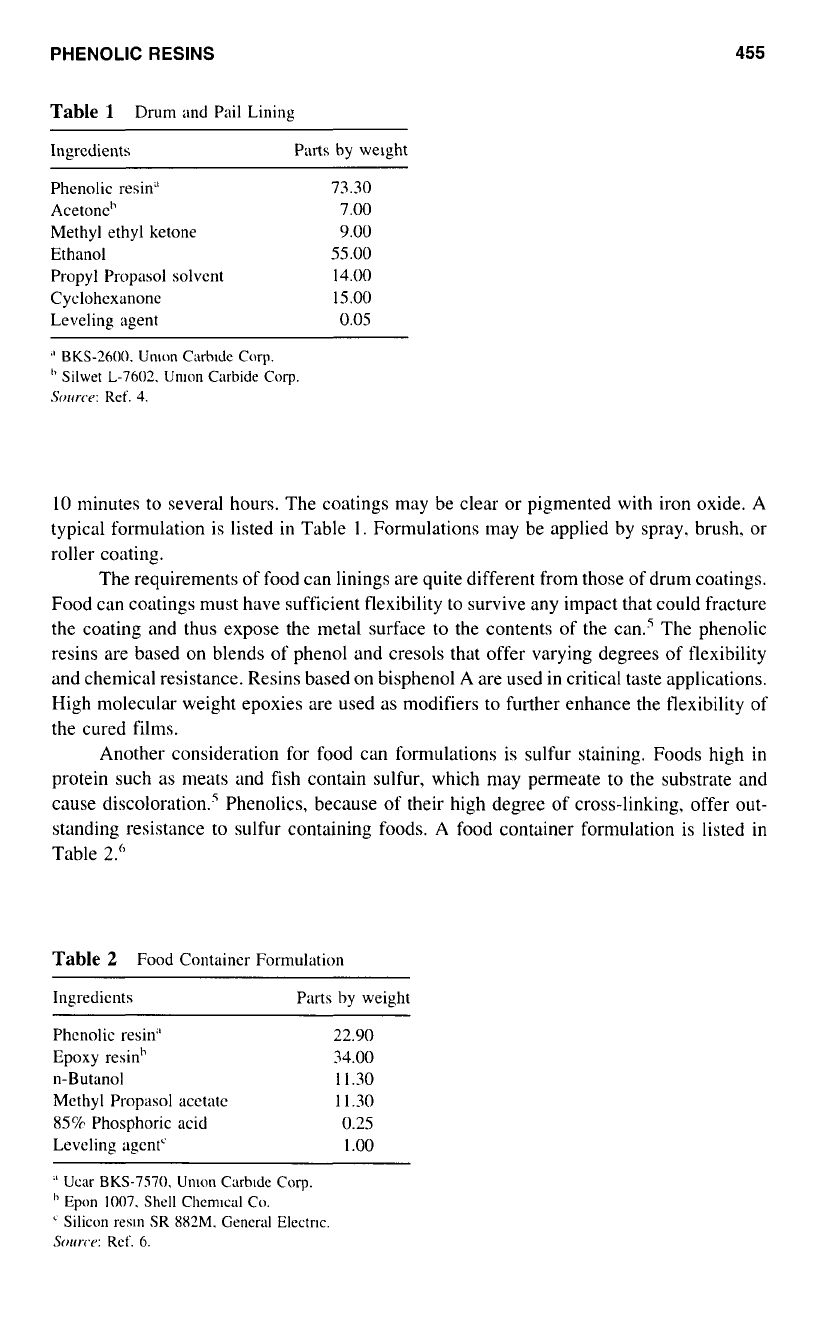
PHENOLIC
RESINS
455
Table
1
Drum and Pail Lining
Ingredients
Parts
by welght
Phenolic resin" 73.30
Acetonc" 7.00
Methyl ethyl ketone 9.00
Ethanol 55.00
Propyl Propasol solvcnt 14.00
Cyclohexanonc 15.00
Leveling agent 0.05
.'
BKS-3600.
Union
Carbde Corp.
"
Silwet L-7603.
Unlon
Carbide
Corp.
Source:
Ret'.
4.
10
minutes to several hours. The coatings may be clear or pigmented with iron oxide. A
typical formulation is listed
in
Table
1.
Formulations may be applied by spray. brush. or
roller coating.
The requirements of food can linings are quite different from those of drum coatings.
Food can coatings must have sufficient flexibility to survive any impact that could fracture
the coating and thus expose the metal surface
to
the contents of the can.' The phenolic
resins are based on blends
of
phenol and cresols that offer varying degrees of flexibility
and chemical resistance. Resins based on bisphenol A are used in critical taste applications.
High molecular weight epoxies are used as modifiers to further enhance the flexibility
of
the cured films.
Another consideration for food can formulations is sulfur staining. Foods high
in
protein such as meats and fish contain sulfur, which may permeate to the substrate and
cause discoloration.5 Phenolics, because of their high degree of cross-linking. offer out-
standing resistance
to
sulfur containing foods. A food container formulation is listed in
Table
2."
Table
2
Food
Container Formulation
Ingredients Parts by weight
Phenolic resin''
22.90
Epoxy resin" 34.00
n-Butanol
1
1.30
Methyl Propasol acetate 11.30
85% Phosphoric acid
0.35
Levcling agent'
1
.OO
"
Ucar
BKS-7570.
Unwn
Corhde Corp.
"
Epon
1007.
Shell
Chemlcal
Co.
L
Silicon
rem
SR X87-M. General
Electric.
Sourw:
Ref.
6.
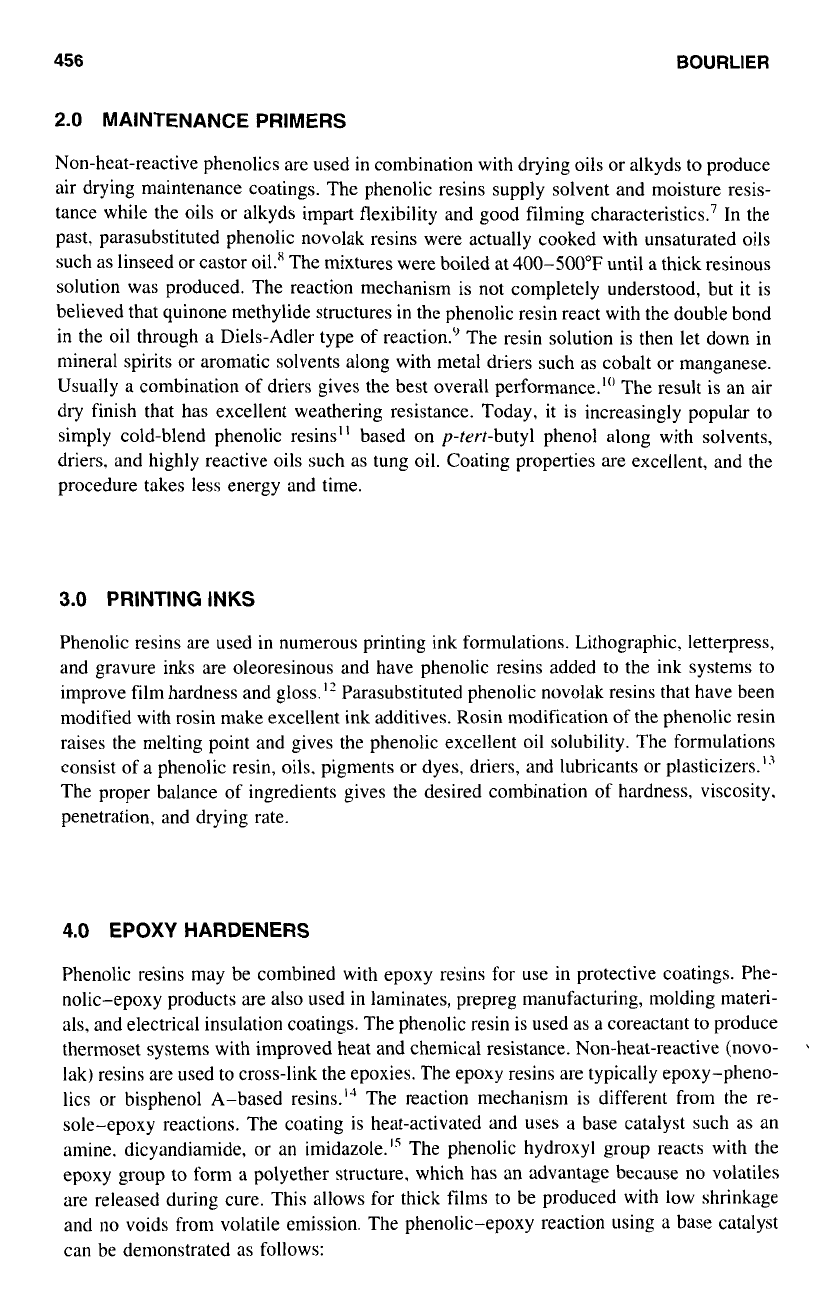
456
BOURLIER
2.0
MAINTENANCE PRIMERS
Non-heat-reactive phenolics are used in combination with drying oils or alkyds
to
produce
air drying maintenance coatings. The phenolic resins supply solvent and moisture resis-
tance while the oils or alkyds impart flexibility and good filming
characteristic^.^
In the
past, parasubstituted phenolic novolak resins were actually cooked with unsaturated oils
such as linseed or castor oil.' The mixtures were boiled at
400-500°F
until a thick resinous
solution was produced. The reaction mechanism is not completely understood, but it is
believed that quinone methylide structures
in
the phenolic resin react with the double bond
in the oil through
a
Diels-Adler type of reaction." The resin solution is then let down in
mineral spirits or aromatic solvents along with metal driers such as cobalt or manganese.
Usually a combination of driers gives the best overall performance."' The result is an air
dry finish that has excellent weathering resistance. Today, it is increasingly popular to
simply cold-blend phenolic resins" based on p-fert-butyl phenol along with solvents,
driers. and highly reactive oils such as tung
oil.
Coating properties are excellent, and the
procedure takes less energy and time.
3.0
PRINTING INKS
Phenolic resins are used in numerous printing ink formulations. Lithographic. letterpress,
and gravure inks are oleoresinous and have phenolic resins added to the ink systems to
improve film hardness and gloss." Parasubstituted phenolic novolak resins that have been
modified with rosin make excellent ink additives. Rosin modification
of
the phenolic resin
raises the melting point and gives the phenolic excellent
oil
solubility. The formulations
consist of
a
phenolic resin, oils. pigments or dyes, driers, and lubricants or plasticizers.I3
The proper balance of ingredients gives the desired combination of hardness, viscosity,
penetration, and drying rate.
4.0
EPOXY HARDENERS
Phenolic resins may be combined with epoxy resins for use in protective coatings. Phe-
nolic-epoxy products are also used in laminates, prepreg manufacturing, molding materi-
als, and electrical insulation coatings. The phenolic resin is used as a coreactant
to
produce
thermoset systems with improved heat and chemical resistance. Non-heat-reactive (novo-
\
lak) resins are used to cross-link the epoxies. The epoxy resins are typically epoxy-pheno-
lics or bisphenol A-based resins." The reaction mechanism is different from the re-
sole-epoxy reactions. The coating is heat-activated and uses a base catalyst such as an
amine, dicyandiamide, or an imidazole." The phenolic hydroxyl group reacts with the
epoxy group to form a polyether structure, which has an advantage because no volatiles
are released during cure. This allows for thick films to be produced with low shrinkage
and
no
voids from volatile emission. The phenolic-epoxy reaction using
a
base catalyst
can be demonstrated as follows:
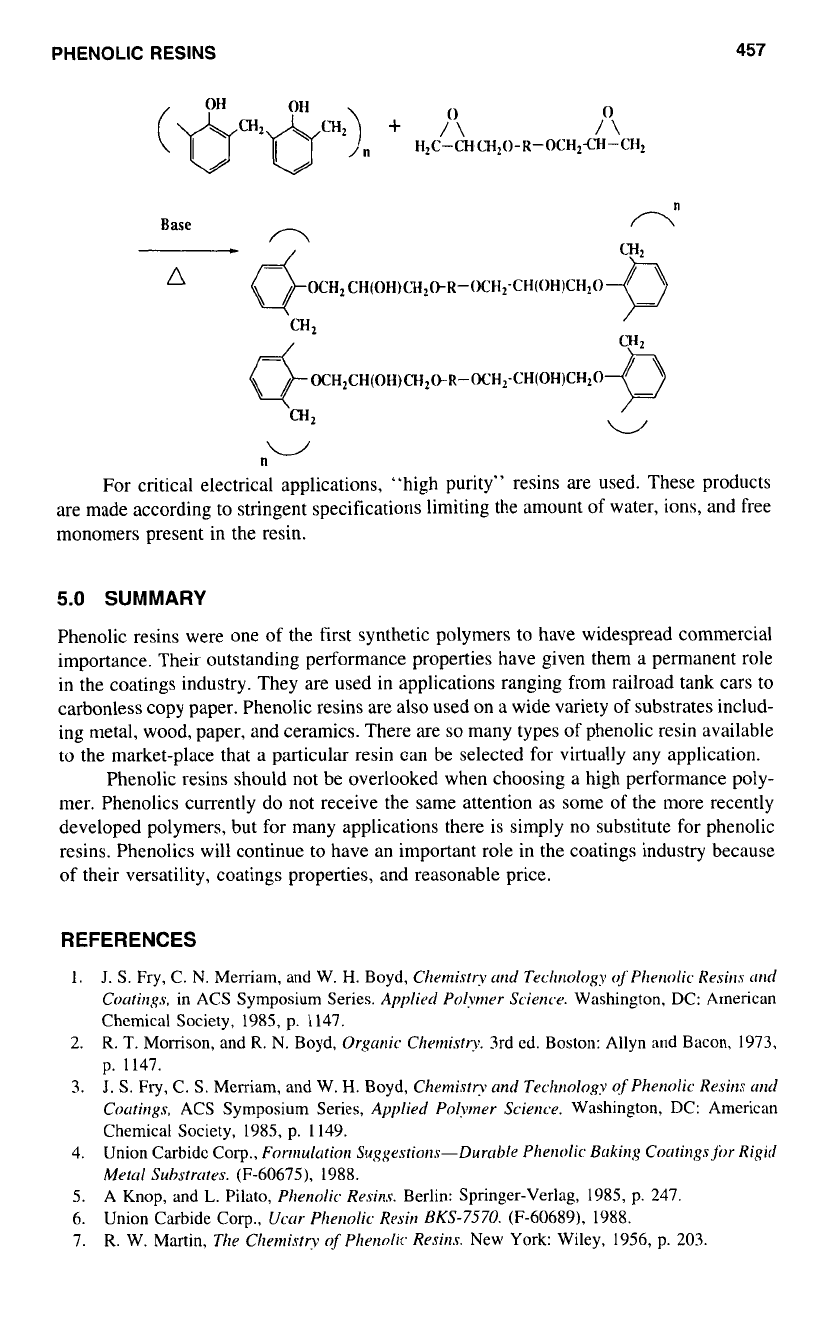
PHENOLIC
RESINS
457
81HzCH(..1-;(~K-..~-CH(oH)cH2~
CH2
3
'
W
W
For critical electrical applications, "high purity" resins are used. These products
are made according to stringent specifications limiting the amount
of
water, ions, and free
monomers present in the resin.
5.0
SUMMARY
Phenolic resins were one
of
the first synthetic polymers to have widespread commercial
importance. Their outstanding performance properties have given them a permanent role
in the coatings industry. They are used in applications ranging from railroad tank cars to
carbonless copy paper. Phenolic resins are also used on a wide variety
of
substrates includ-
ing metal, wood, paper, and ceramics. There are
so
many types of phenolic resin available
to the market-place that a particular resin can be selected for virtually any application.
Phenolic resins should not be overlooked when choosing a high performance poly-
mer. Phenolics currently do not receive the same attention as some of the more recently
developed polymers, but for many applications there is simply no substitute for phenolic
resins. Phenolics will continue
to
have an important role in the coatings industry because
of
their versatility, coatings properties, and reasonable price.
REFERENCES
1.
2.
3.
4.
5.
6.
7.
J.
S.
Fry, C.
N.
Merriam, and W.
H.
Boyd,
Cllemistry
L~JI~
Ted~~tol~gy
of'Pllenolic
Resins
td
Cocrtings,
in ACS Symposium Series.
App/ied
Polvnler
Science.
Washington, DC: American
Chemical Society, 1985, p. 1147.
R.
T.
Morrison, and
R.
N. Boyd,
Orgmic Chernistry.
3rd ed. Boston: Allyn and Bacon, 1973,
J.
S.
Fry,
C.
S.
Merriam, and W.
H.
Boyd,
Chemistv
and
Technologv
offhenolic
Resins
~nd
Cocltings,
ACS Symposium Series,
Applied
Po/ymer
Science.
Washington, DC: American
Chemical Society, 1985,
p.
1149.
Union Carbidc Corp.,
Forrwlcltiorl
SuRgestioils-Durrrble Phenolic
Bokirl!:
Coofingsfbr Rigid
Metcrl
Suhstrcrtes.
(F-60675), 1988.
A Knop, and
L.
Pilato,
Phenolic
Resirls.
Berlin: Springer-Verlag, 1985,
p.
247.
Union Carbide Corp.,
Ucar
Pl~e~~olic
Resin
BKS-7570.
(F-60689), 1988.
R.
W. Martin,
The
Cllemistry
of
Phenolic
Resins.
New York: Wiley, 1956,
p.
203.
p. 1147.
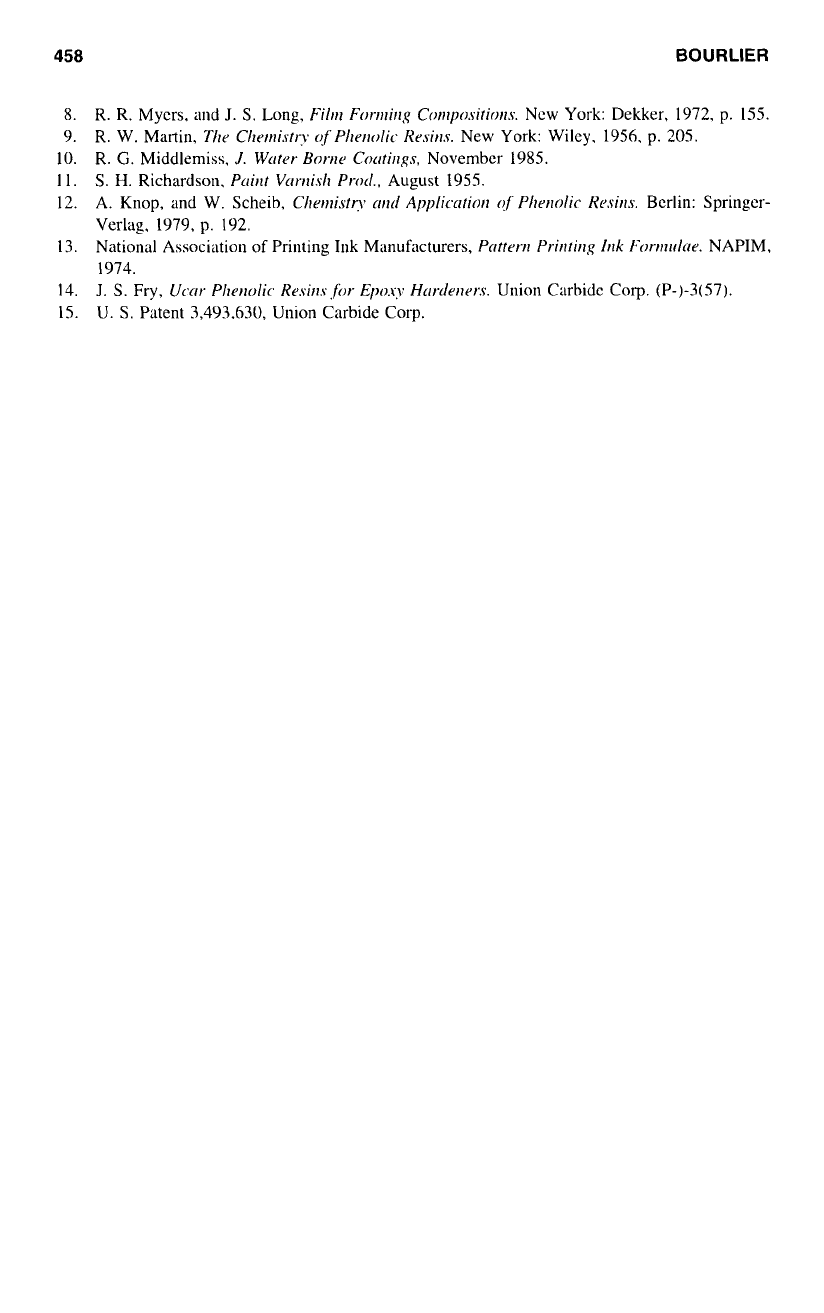
458 BOURLIER
8.
9.
IO.
11.
12.
13.
14.
15.
R. R.
Myers. and
J.
S.
Long,
Film
Forwing
Corly7cl.sitiorl.s.
Ncw York: Dekker, 1972,
p.
155.
R.
W. Martin,
The
Clwrrlistry
of
Pherlolic
Hesir~s.
New York: Wilcy. 1956. p.
205.
R.
G.
Middlemiss.
J.
Wtrter
Borne
Cotrtirlgs,
November
1985.
S.
H.
Richardson,
Pairlt
Vurrzish
Prod..
August
1955.
A.
Knop, and W. Scheib,
Cherllistr?.
m~d
Applicrctior~
of
Plzerzolic
KP.S~IIS.
Bcrlin: Springcr-
Verlag. 1979,
p.
192.
National Association of Printing Ink Manufacturers,
Pntterrl
Printing
Ink
Formrlcre.
NAPIM,
1974.
J.
S.
Fry,
Ucor
Pherlolic
Resir~.s
filr
Epo.xy
Hurthers.
Union Cnrbidc Corp. (P-)-3(57).
U.
S.
Patent 3,493.630, Union Carbide Corp.
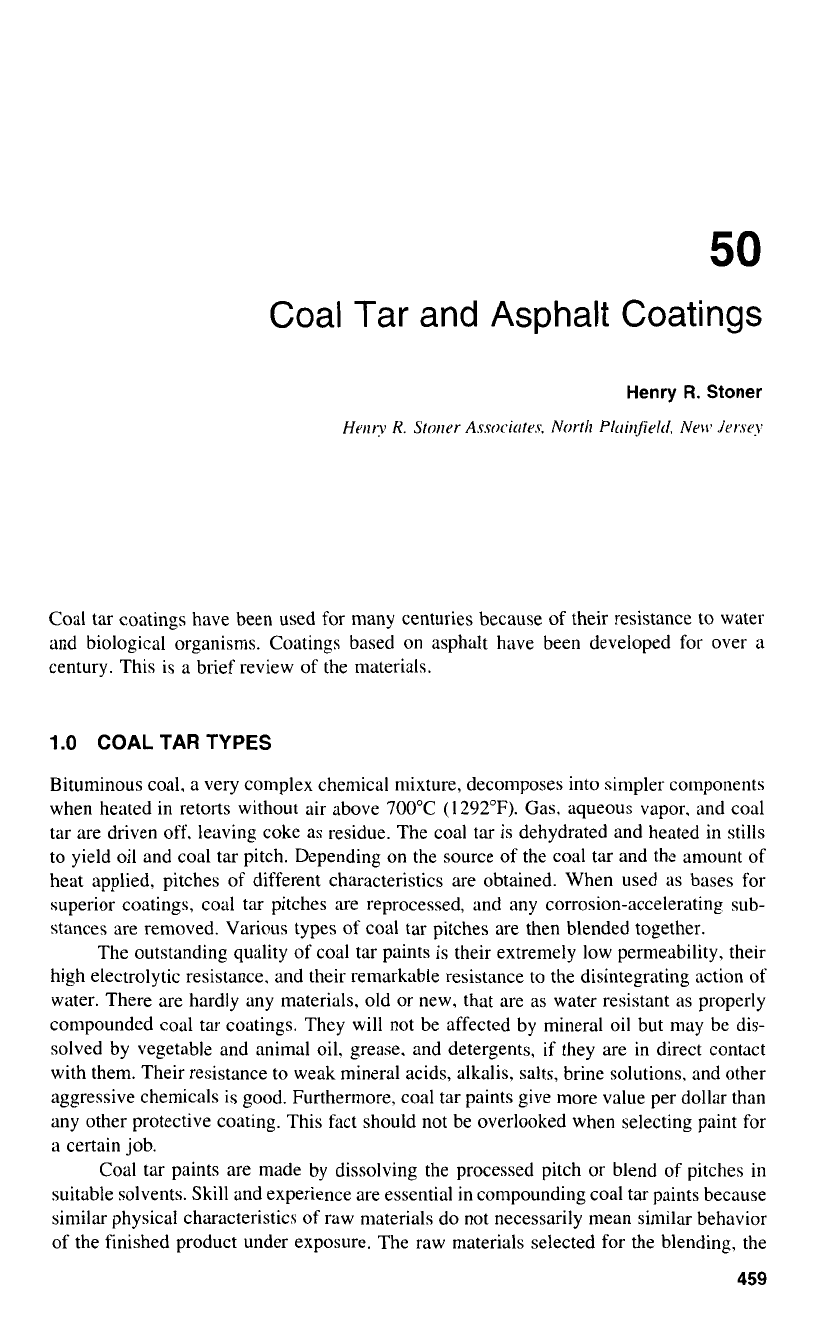
50
Coal
Tar
and Asphalt Coatings
Coal tar coatings have been used for many centuries because
of
their resistance to water
and biological organisms. Coatings based
on
asphalt have been developed for over a
century. This is a brief review of the materials.
1.0
COAL TAR TYPES
Bituminous coal, a very complex chemical mixture, decomposes into simpler components
when heated in retorts without air above 700°C
(1
292°F).
Gas,
aqueous vapor. and coal
tar are driven
off.
leaving coke as residue. The coal tar is dehydrated and heated in stills
to yield oil and coal tar pitch. Depending
on
the source of the coal tar and the amount of
heat applied, pitches of different characteristics are obtained. When used as bases for
superior coatings, coal tar pitches are reprocessed, and any corrosion-accelerating sub-
stances are removed. Various types of coal tar pitches are then blended together.
The outstanding quality
of
coal tar paints is their extremely low permeability, their
high electrolytic resistance, and their remarkable resistance to the disintegrating action of
water. There are hardly any materials. old or new, that are
as
water resistant as properly
compounded coal tar coatings. They will not be affected by mineral oil but may be dis-
solved by vegetable and animal
oil.
grease. and detergents, if they are in direct contact
with them. Their resistance
to
weak mineral acids, alkalis, salts, brine solutions. and other
aggressive chemicals is good. Furthermore, coal tar paints give more value per dollar than
any other protective coating. This fact should not be overlooked when selecting paint for
a
certain job.
Coal tar paints are made by dissolving the processed pitch or blend of pitches in
suitable solvents. Skill and experience are essential in compounding coal tar paints because
similar physical characteristics
of
raw materials do
not
necessarily mean similar behavior
of the finished product under exposure. The raw materials selected for the blending, the
459
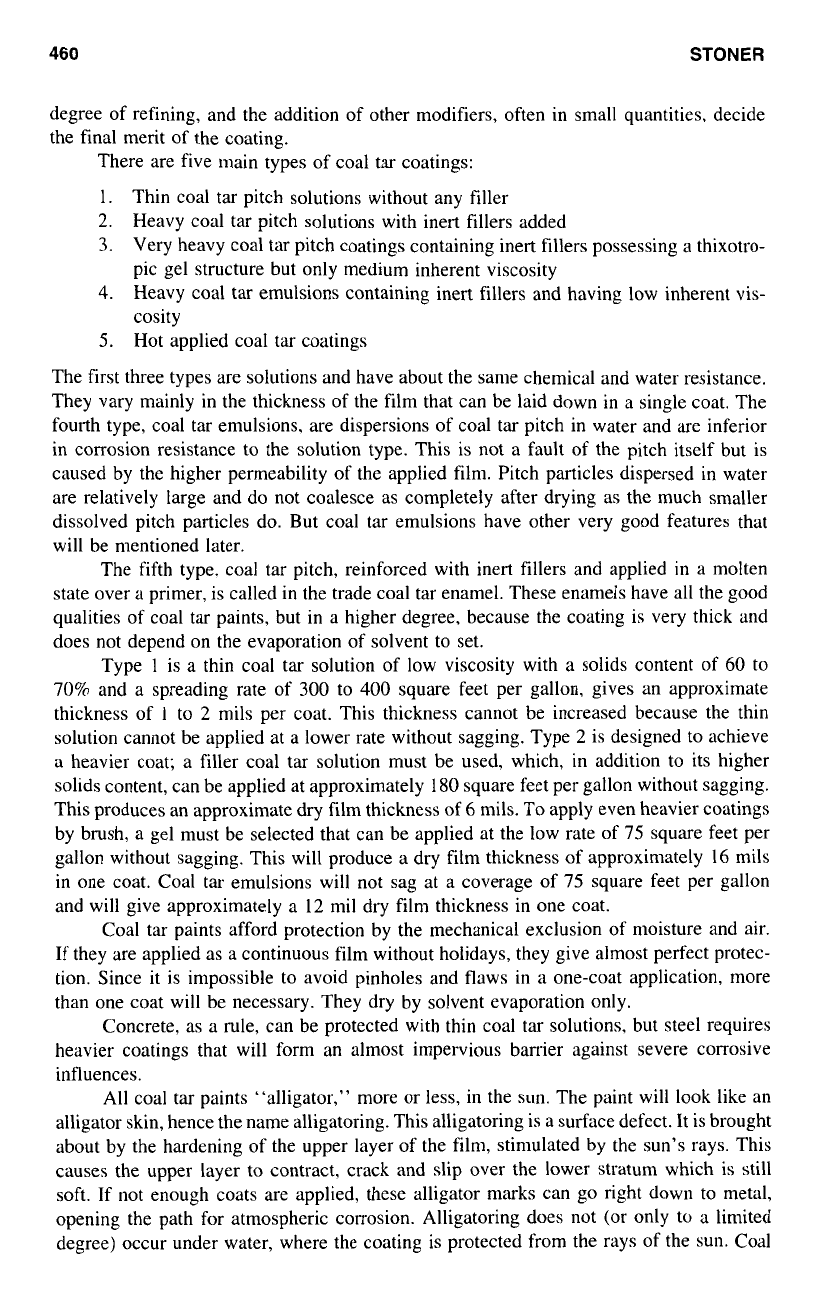
460
STONER
degree of refining, and the addition of other modifiers, often in small quantities, decide
the final merit of the coating.
There are five main types
of
coal tar coatings:
1.
Thin coal
tar
pitch solutions without any filler
2. Heavy coal tar pitch solutions with inert fillers added
3.
Very heavy coal tar pitch coatings containing inert fillers possessing a thixotro-
4.
Heavy coal tar emulsions containing inert fillers and having low inherent vis-
5.
Hot applied coal tar coatings
pic gel structure but only medium inherent viscosity
cosity
The first three types are solutions and have about the same chemical and water resistance.
They vary mainly in the thickness of the film that can be laid down in a single coat. The
fourth type, coal tar emulsions, are dispersions of coal tar pitch in water and are inferior
in corrosion resistance to the solution type. This is not
a
fault of the pitch itself but is
caused by the higher permeability
of
the applied film. Pitch particles dispersed in water
are relatively large and do not coalesce
as
completely after drying
as
the much smaller
dissolved pitch particles do. But coal tar emulsions have other very good features that
will be mentioned later.
The fifth type, coal tar pitch, reinforced with inert fillers and applied in a molten
state over
a
primer, is called in the trade coal tar enamel. These enamels have all the good
qualities of coal tar paints, but in a higher degree, because the coating is very thick and
does not depend on the evaporation
of
solvent to set.
Type
1
is a thin coal tar solution of low viscosity with
a
solids content of 60
to
70% and a spreading rate of 300 to 400 square feet per gallon, gives an approximate
thickness of
1
to
2 mils per coat. This thickness cannot be increased because the thin
solution cannot be applied at a lower rate without sagging. Type 2 is designed to achieve
a heavier coat;
a
filler coal tar solution must be used, which, in addition to its higher
solids content, can be applied at approximately 180 square feet per gallon without sagging.
This produces an approximate dry film thickness
of
6 mils. To apply even heavier coatings
by brush,
a
gel must be selected that can be applied at the low rate of 75 square feet per
gallon without sagging. This will produce
a
dry film thickness of approximately 16 mils
in one coat. Coal tar emulsions will not sag at
a
coverage of 75 square feet per gallon
and will give approximately a 12 mil dry film thickness in one coat.
Coal tar paints afford protection by the mechanical exclusion of moisture and air.
If they are applied as a continuous film without holidays, they give almost perfect protec-
tion. Since it is impossible
to
avoid pinholes and flaws
in
a
one-coat application, more
than one coat will be necessary. They dry by solvent evaporation only.
Concrete,
as
a
rule, can be protected with thin coal tar solutions, but steel requires
heavier coatings that will form
an
almost impervious barrier against severe corrosive
influences.
All coal tar paints “alligator,” more or less, in the sun. The paint will look like an
alligator skin, hence the name alligatoring. This alligatoring is
a
surface defect. It is brought
about by the hardening of the upper layer
of
the film, stimulated by the sun’s rays. This
causes the upper layer to contract. crack and slip over the lower stratum which is still
soft. If not enough coats are applied, these alligator marks can go right down to metal,
opening the path for atmospheric corrosion. Alligatoring does not
(or
only to a limited
degree) occur under water, where the coating is protected from the rays of the sun. Coal
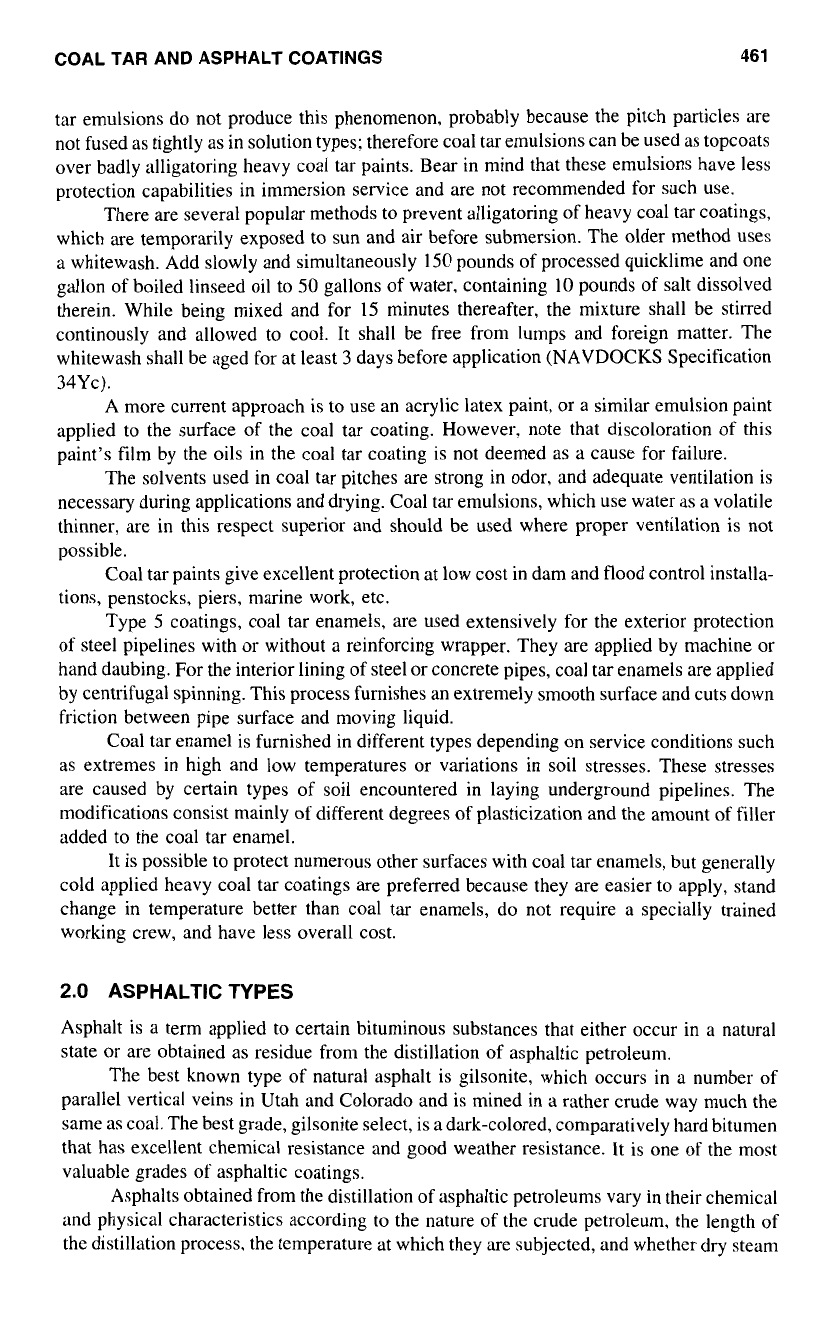
COAL TAR AND ASPHALT COATINGS
461
tar
emulsions do not produce this phenomenon, probably because the pitch particles are
not fused
as
tightly
as
in solution types: therefore coal tar emulsions can be used as topcoats
Over badly alligatoring heavy coal tar paints. Bear in mind that these emulsions have less
protection capabilities in immersion service and are not recommended for such use.
There are several popular methods
to
prevent alligatoring of heavy coal tar coatings,
which are temporarily exposed to sun and air before submersion. The older method uses
a
whitewash. Add slowly and simultaneously 150 pounds of processed quicklime and one
gallon of boiled linseed oil to 50 gallons of water, containing
10
pounds
of
salt dissolved
therein. While being mixed and for
15
minutes thereafter, the mixture shall be stirred
continously and allowed to cool. It shall be free from lumps and foreign matter. The
whitewash shall be aged for at least
3
days before application (NAVDOCKS Specification
34Yc).
A more current approach is to use an acrylic latex paint, or
a
similar emulsion paint
applied to the surface
of
the coal tar coating. However. note that discoloration of this
paint’s film by the oils in the coal tar coating is not deemed
as
a
cause for failure.
The solvents used in coal tar pitches are strong in odor, and adequate ventilation is
necessary during applications and drying. Coal tar emulsions, which use water
as
a
volatile
thinner, are in this respect superior and should be used where proper ventilation is not
possible.
Coal tar paints give excellent protection at low cost in dam and flood control installa-
tions, penstocks, piers, marine work, etc.
Type
5
coatings, coal tar enamels, are used extensively for the exterior protection
of steel pipelines with or without
a
reinforcing wrapper. They are applied by machine or
hand daubing. For the interior lining of steel or concrete pipes, coal tar enamels are applied
by centrifugal spinning. This process furnishes an extremely smooth surface and cuts down
friction between pipe surface and moving liquid.
Coal tar enamel is furnished in different types depending on service conditions such
as
extremes in high and low temperatures or variations in soil stresses. These stresses
are caused by certain types of soil encountered in laying underground pipelines. The
modifications consist mainly
of
different degrees
of
plasticization and the amount of filler
added to the coal tar enamel.
It is possible to protect numerous other surfaces with coal tar enamels, but generally
cold applied heavy coal tar coatings are preferred because they are easier to apply, stand
change in temperature better than coal tar enamels, do not require
a
specially trained
working crew, and have less overall cost.
2.0
ASPHALTIC TYPES
Asphalt is
a
term applied
to
certain bituminous substances that either occur in
a
natural
state or are obtained
as
residue from the distillation of asphaltic petroleum.
The best known type of natural asphalt is gilsonite, which occurs in
a
number of
parallel vertical veins in Utah and Colorado and is mined in
a
rather crude way much the
same
as
coal. The best grade, gilsonite select, is
a
dark-colored, comparatively hard bitumen
that has excellent chemical resistance and good weather resistance. It is one
of
the most
valuable grades of asphaltic coatings.
Asphalts obtained from the distillation of asphaltic petroleums vary in their chemical
and physical characteristics according
to
the nature
of
the crude petroleum, the length
of
the distillation process. the temperature at which they are subjected, and whether dry steam
